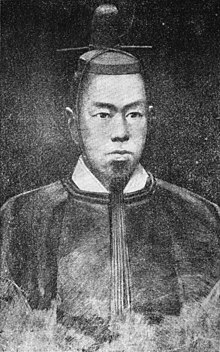Emperor Kōmei
| Emperor Kōmei 孝明天皇 |
|||||
|---|---|---|---|---|---|
 |
|||||
| Emperor of Japan | |||||
| Reign | 10 March 1846 – 30 January 1867 | ||||
| Enthronement | 10 March 1846 | ||||
| Predecessor | Ninkō | ||||
| Successor | Meiji | ||||
| Shoguns | |||||
| Born | 22 July 1831 | ||||
| Died | 30 January 1867 (aged 35) | ||||
| Burial | Higashiyama-ku, Kyoto | ||||
| Spouse | Asako Kujō | ||||
| Issue | 6 (inc. Emperor Meiji) |
||||
|
|||||
| House | Imperial House of Japan | ||||
| Father | Emperor Ninkō | ||||
| Religion | Shinto | ||||
| Full name | |
|---|---|
| Osahito (統仁?) |
Emperor Kōmei (孝明天皇 Kōmei-tennō?, 22 July 1831 – 30 January 1867) was the 121st emperor of Japan, according to the traditional order of succession.
Kōmei's reign spanned the years from 1846 through 1867.
Before Kōmei's accession to the Chrysanthemum Throne, his personal name (imina) was Osahito (統仁?); his title was Hiro-no-miya (煕宮?).
Emperor Kōmei was the fourth son of Emperor Ninkō and his consort Fujiwara-no-Tsuneko (藤原雅子). Kōmei's Imperial family lived with him in the Dairi of the Heian Palace. The family included six children, four daughters and two sons; but the future Emperor Meiji was the only one to survive childhood.
The Kōmei principal consort was Asako Kujō (九条夙子). After Kōmei's death in 1867, Asako was given the title Empress Eishō (英照皇后) by Emperor Meiji.
...
Wikipedia
